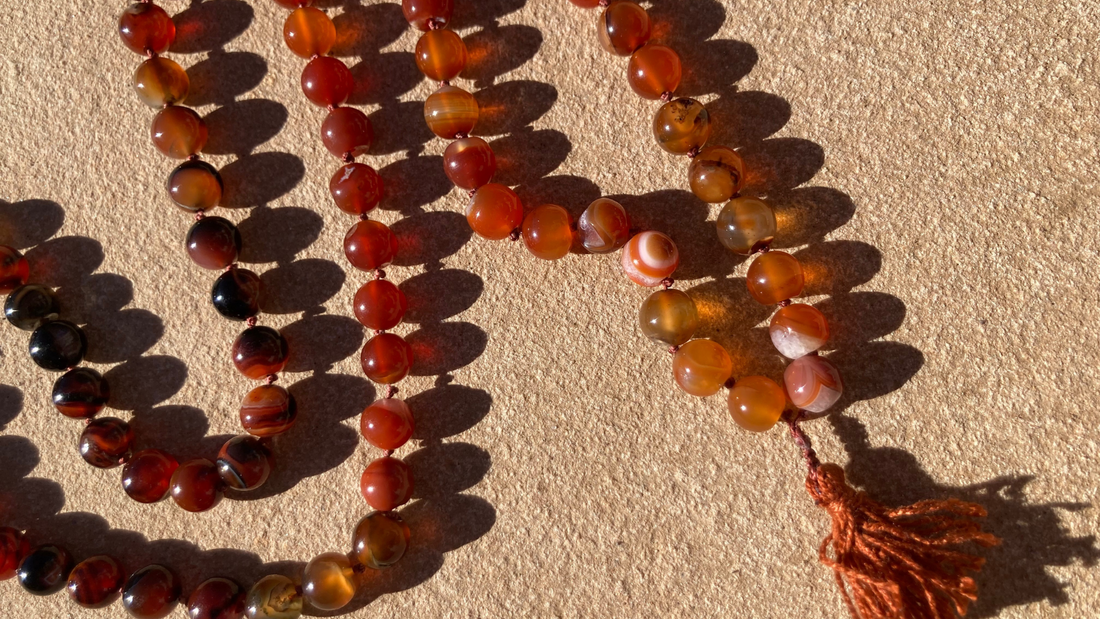A mala (meaning “garland” in Sanskrit) is a looped strand of prayer beads used to keep count during prayer, mantra recitation, meditation, and other spiritual or devotional activities. It is also worn for warding off evil, and as a reminder of one’s intentions. Malas can be worn during meditation, and as a necklace or wrapped around your wrist several times. Malas have been used for millennia, with some of the earliest examples dating back to the 8th century BC. While malas have their origins in dharmic religions, the mala has been widely popularized and is now associated with yogic practices worldwide.
Why 108 Beads?
While traditional malas had 108 beads, you can find malas of many sizes in some fraction of that number. While 108 is a fascinating number mathematically speaking (join me, math geeks!), it is also a sacred number in many belief systems, especially the dharmic religions. To give you a taste:
- In Jainism, there are 108 ways of karmic influx.
- In Buddhism, 108 is the number of mankind’s mortal desires we must overcome to achieve nirvana.
- There are 108 volumes in the Kangyur, which contains words directly spoken by the Buddha.
- Many Japanese Buddhist temples will ring a bell 108 times to greet the new year, thereby banishing each of the 108 worldly desires.
- There are 108 Upanishads, the sacred Hindu texts.
- In Ayurveda, the subtle body has 108 marmas (energy intersections).
- The first manned space flight in 1961 by Soviet cosmonaut Yuri Gagarin lasted 108 minutes (yes!).
- So many more fascinating goodies here.
How to Use Your Mala
A mala consists of the beads, usually separated by knots. There may or may not be marker beads, a guru bead, and a tassel. Each element of the mala carries significance. The beads are used to keep count during mantra recitation, prayer, or pranayama (breathwork). This is ideally done in a setting where you can maintain a mindset of sincerity and attention. Hold the strand in your hand, starting with the guru bead if it is present. The guru bead (also called the meru, or mountain, bead) is the 109th bead and is not counted as part of the practice - it is used to hold your intention. So as you begin, hold the guru bead and set your intention. Moving along the strand, each bead corresponds to one full recitation of your mantra or intention. If you are using the mala during pranayama (some techniques here), then one bead can correspond to one full cycle of the breath. When you have completed moving along the strand, you can seal your practice by resting on the guru bead again to return to your intention.
Some malas may have marker beads, which are beads of different size or shape stationed along the mala at specific intervals. Markers can be used to mark your place (duh!), and return to your intention during your practice. Malas may also have a tassel, commonly made from cotton or silk for a pleasing texture. Tassels represent a connection to your spirit, or highest truth. If you are into essential oils, you can also place a few drops of your favorite on the tassel to add a lovely scented sensory element to your practice.
About Mikken Malas
All high-quality malas are hand-knotted, including those we make here at Mikken. This protects the mala beads from rubbing against each other, and allows your fingers to move easily along the strand during your practice. The knots also provide a beautiful drape if you are wearing your mala as a necklace or wrapped around your wrist as a bracelet. And, should your mala break, the knots keep the majority of the beads secure. Should your mala break, simply contact us and we will repair it!
Get (or Design!) Your Very Own Mala
Ready for your very own male? Check out what we have in stock!
Don’t see something that resonates? We adore custom work, check out our bespoke process and reach out to let us know what you are looking for!

